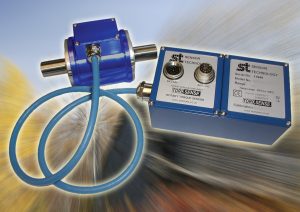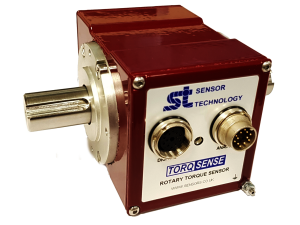Available in other languages:
![]()
Sensor Technology, the company that developed practical non-contact torque measurement, will once again unveil a major innovation at the M-Tec Exhibition.
New for 2008 is TorqSense RWT330/340 series, designed for use in applications where space is limited. Like other units in the TorqSense family, the RWT330/340 provides non-contact measurement of torque, speed, power and position of rotating shafts, such as machine drives, drive shafts for pumps, fans, mixers etc, and in the critical axes of test rigs.
As more and more applications are found for TorqSense, a number of popular requests have been noted, as Tony Ingham explains:
 “At its launch TorqSense was nothing short of revolutionary, since when it has steadily grown in popularity with enquiries constantly coming in from new fields. Last year, in response to requests, we showed at M-Tec our expanded range up to 10,000Nm since TorqSense can be applied to virtually any size of system where precise yet simple torque monitoring is required.”
“At its launch TorqSense was nothing short of revolutionary, since when it has steadily grown in popularity with enquiries constantly coming in from new fields. Last year, in response to requests, we showed at M-Tec our expanded range up to 10,000Nm since TorqSense can be applied to virtually any size of system where precise yet simple torque monitoring is required.”
“We also get requests to fit TorqSense into very small spaces, so now the design team has come up with a solution by separating the sensing head from the control electronics to form a two-part unit. The head is very compact so can be fitted into the tiniest of spaces, while the electronics can be sited at a convenient place further from the shaft under test.”
TorqSense uses tiny piezo-ceramic combs fixed to the transducer’s shaft that distort in proportion to the instantaneous torque level. These create data signals that are transmitted via a non-contact radio frequency coupling rather than by conventional but clumsy slip rings, or high enertia rotary transformers. Because piezo technology requires so little power, this is also supplied via the RF coupling.
This data signal is transmitted to the control unit, from which it can be read on an alpha-numeric display or transferred to a PC for storage and analysis using the TorqView software programme.
“Our larger sensors are used in many applications at the heavy duty end of industry, our smaller ones are used in applications such as fine chemical dosing and lab-based research,” says Tony. “At both ends of this spectrum are applications where splitting the sensing head from the control electronics is desirable. It maybe a space constraint or it may be a matter of protecting the electronics from harsh environmental conditions such as heat, damp, noise, vibration or EMC.”
“What TorqSense is about is reliably collecting high speed real-time torque data. With that captured and secure, TorqView can display it via on-screen virtual instruments so users can perform a full range of analysis.”





